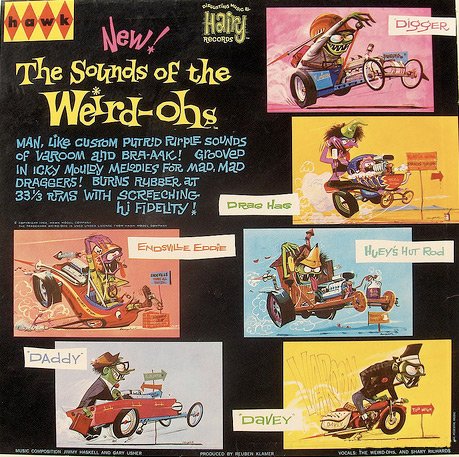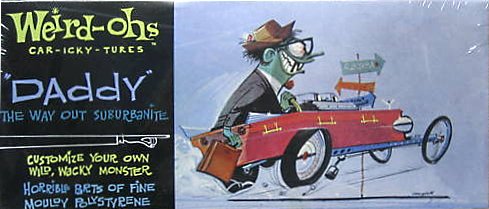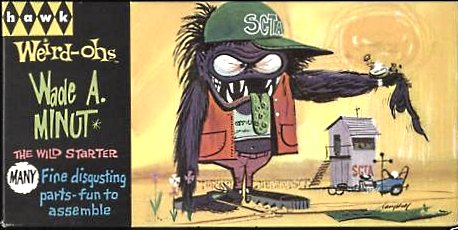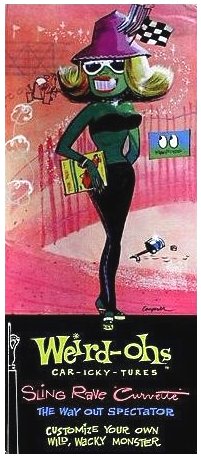By Bill Campbell -Edited by Alan Bussie Google+ profile
When he provided me the information for his biography and Hawk Model Company, Bill was kind enough to write a history of the phenomenal “Weird-Ohs” model kits that he developed. – AB
After reviewing some of the dangling questions voiced on the internet by people wanting to close the circle of the Weird-Ohs, I decided to write this article. I will do my best to finally resolve the Who, What and Why questions that you have articulated on your electronic cyber queries.
“Daddy”, one of the original Weird-Oh figures (Hawk Reissue)
The Weird-Ohs were produced from 1963 forward by the Hawk Model Company in Chicago, IL. Hawk is perhaps the oldest model company in the USA, dating back to 1928. My relationship with Hawk was a close one, as I was usually busy producing box artwork for them. For more information on how I met up with Hawk, please read the biography located on this website. Now I’ll head into what you really wanted to know – about the Weird-Ohs.
How did they come about?
In about 1962 I was sure that most model builders were growing weary of just another car or plane kit. So one day, I put on the thinking cap and tried to come up with something that was way out. I made five hand-made prototype models of some of my funkiest thoughts. If memory serves me correctly, they were Digger, Davey, Daddy (in his own personal movable coffin), and also Col Frtizgrubber flying his Eindecker shoulder-wing aircraft and dropping bombs by hand. There was also a submarine – German of course, with captain Dukvasser and his Underbotten, complete with torpedoes coming out the forward tubes.
I took my models along in one of my frequent trips to Hawk. Dick and Phil Mates, the owner and founders, said “They are interesting. We’ll see what the folks think.” This was in the days before focus groups, so I left them at Hawk. I did not dwell on their acceptance too much, for at the same time Desoto Chemical Coatings was considering me for the position of Corporate Creative Director. This was an exciting job and it encompassed all five divisions – Paint, Detergents, Lighting, Furniture and Aerospace coatings. The final division included airplane paints and ablative finishes for space re-entry vehicles.
I didn’t find out till much later that Dick and Phil were not overly thrilled with my offerings. John Andrews, the marketing director, took a look and said that Hawk probably should not deviate from the traditional path of “…producing mechanical wonders in miniature.” The models were left on the conference table to await their fate.
Later in that same week, Hawk was hosting a group of their distributors in Chicago. After the obligatory tour of the plant they ended up in the conference room. The distributors caught sight of the crazy, funky little models, and they went for the idea behind them. Dick and Phil, hearing a vote of confidence from those who sell the items they produce, reconsidered their initial judgment. At any rate, I got a call from John Andrews to come in to talk about the possibility of production. Hawk wanted to take a chance and offer the kits at the next hobby show at the Sherman Hotel in Chicago. The hobby show was always a great way to gauge reaction to new products. But for now, the initial concern was “What do we call them?” It was my off-hand remark that must have hit home, for I said “Oh they are just a bunch of Weird-Ohs.” So they all agreed that would be their name.
Hawk reissue of the “Endsville Eddie” Weird-Oh
Development
To produce the Weird-Ohs in time for the next show appeared to be an almost impossible task – and it would have been if they were produced traditionally. Time was running short, so John and I developed a plan of action. Since most of my models and conceptual drawings started on the premise that ‘wheels’ were the primary element, the first model would be “Digger”, then “Daddy” then “Davey”. It was decide that I would start on the finish art for the box top while John would start on creating the dies. This is why there is a great disconnect between the box art and the model. Rather than develop the figure through my art, John went directly into cutting the dies. In other words, the dies were not cut by looking at the box art, and the box art was not painted by looking at a completed model or even engineering drawings of the dies. There was only one prototype model of “Digger” and to my knowledge there was no pantographing of this model. John literally interpreted my first rough model directly into steel.
The tremendous pressure to make the show was primarily responsible for the arrangement, but John may have seen this as an opportunity to put his imprint on it. All through history, when two creative minds are placed in charge of a project, both will vie for recognition in the final result. After I completed the finish art, I saw the drawings of the die blocks that were already being cut. I realized that we had finish box art that did not faithfully represent the figure that the modeler would assemble. However, The Mates brothers were the ones gambling the money. I was not. All I was betting was a conviction, so I simply backed off.
The 1963 Chicago Hobby Convention
The box art and the actual models of maybe six of the Weird-Ohs were ready for the Chicago Hobby Convention. I am sure that at least Digger, Daddy and Davey were present, along with the usual aircraft, cars and boats in the big Hawk display booth. At first people didn’t know how to take them – then they became the talk of the convention. The Hawk salespeople started writing up orders- thousands of them! The show and the introduction of the funny characters was a roaring success. Orders soon topped hundreds of thousands. The factory had to go into overtime. The popularity was such that even as the mold machines banged around the clock, the shelves ran dry of Weird-Oh kits.
“Wade A. Minut” from the second set of Hawk Weird-Ohs
Expansion
So John and I set down the long road of developing more Weird-Ohs together. After we exhausted the ‘wheel’ models, we decided that sports figures would be a plausible direction. On came ‘Francis”, “Killer McBash” and “Wade A Minut”. John suggested that the Weird-Ohs craze could be expanded to other aspects of the hobby industry. Soon they were on trading cards, Fleers gum, Milton Bradley games, decals, records, helmets and puzzles. You name it- they were capitalizing on the Weird-Ohs name.
Weird-Ohs Puzzle by Fairchild showing four of the original characters

Sounds of the Weird-Ohs” Record
The Surfers
Of course this was all happening at the same time as the Munsters and Addams Family, so those factors helped spark interest in the whole weird idea. The interest in unusual models had an effect on a California man by the name of Rueben Klamer, who is the inventor of the ‘Game of Life” by Milton Bradley. Upon seeing the phenomenon, he got together a wonderful artist (whose name I don’t know) and the sculptor Bob Allen. They came up with the name ‘Silly Surfers’ and produced a whole series. ‘Hot Dogger Hanging Ten” and “Beach Bunny Catching Rays” were just a few. I had never seen a more beautiful presentation that these prototypes. Every one was a wonderful diorama. Hawk, piggy-backing on the Weird-Ohs, grabbed the opportunity and bought the complete collection. The only thing they did not have was box art. I produced art for the entire collection- the ‘Surfers’ as well as the later ‘Frantics.’

Silly Surfers “Beach Bunny Catchin’ Rays”
Have you ever tried to assembly any of the Surfers? Because of the haste to get them to market, even more short cuts had to be taken. Rather than enlarging the models and removing any imperfections, they decided to pantograph directly from Rueben’s display dioramas. The result was a far from easy model to assemble- I know because I put them together for a friend. Getting the parts to align without pins was quite a task. But one thing you can say is that the box art is accurate to the models.
Hawk received a good return on their investment in these off-beat adventures. After the craze had run its course, they returned to the old tried and true aircraft. It served Hawk well until they sold off to Testors in Rockford, Ill.
Testors
I don’t think that Testors really knew what to do with the Weird-Ohs. Initially they renamed them “Groovies”. Testors reissued them, and the box art was photographs of the built up models. All that did was accentuate how static and strange the whole concept was. They eventually went back to using computer-manipulated art from the old boxes. At one point they asked me to do finish art for the ones they could not find. I didn’t get the job, so my price must have scared them off.
Weird-Ohs and Television
One day Phil Mate drove me out to the Milwaukee airport. When we arrived, I thought he wanted me to do the art on an unusual airplane. We walked over to a hanger, and he lifted the door. Inside was a beautiful Cessna Skylane. He rolled the aircraft out to the ramp and said “Bill, get in. You don’t have to worry, I have my Commercial License.” So he flew me to Rockford and back. I knew Phil was a certified aviation nut, so I said “Phil, this is the Penultimate culmination of all your dreams, isn’t it?” He smiled and said “I could not be as happy as I am today.” Then he dropped the bomb and announced – “Testors sortied into TV with the Weird-Ohs!” I was completely surprised.
Since it is easier to be a historian rather than a prophet, I can only say that the TV program missed its mark. I‘m sure the objective was to create a new market of young Weird-Ohs customers. I could see the rationale for re-working the figures, like the eyelids and less threatening mouth elements. But on the screen, the entire concept took on a different look and feel. But the on-screen presentation of hordes of them was akin to watching a Chinese fire drill. I don’t blame the producers of the film, for they had the objective laid down by Testors – “We want to sell Weirdo-Ohs – all 20 of them.”
The debut of their longevity was terminal to say the least. But they do get an “E” for effort in trying to redesign the Weird-Ohs to the new action-oriented crowd. I really like what the “fix-er-uper” did with Davey. The face has the potential of more mobility. The Gals he made more cutsie to appeal to the young girls, where as Slingrave was just sexy. But another reason for the failure of the re-introduction was that to children of a new age, static figures were just not as cool. It was all summed up at one of the plastic model shows. A distributor overheard two teenage boys were looking at an array of aircraft carriers, figures, etc. One turned to the other and said, “But what do they DO?” They were obviously the first Game Boy aficionados.
Aftermath
After the Weird-Ohs ran their course, I left to take the Creative Director position at Desoto. The departure from Hawk was a friendly one. Five years later, I ran into John Andrews at a graphics convention. As we greeted each other, he asked me what I was doing. I told him of my position with Desoto, and he retorted, “You probably went with them because you couldn’t come up with an encore.” John didn’t know that I had done the ‘Despicables’, another collection they never saw “for the parade had passed us by.” Thomas Wolfe said “You can never go back.” But that does not stop people from trying to relive just a touch of those golden halcyon days of their young care-free lives by buying the reissues of the classic plastic Weird-Ohs kit by the new Hawk Company.
Conclusion
So in a nutshell, to use the music vernacular-
Weird-Ohs – A composition by W. Campbell, creator and artist with variations by John Andrews, designer of the dies and superb merchandiser
To the men at Hawk – Dick Sr. and Phil Mates, Dick Mates Jr., John Andrews, Bob Chalander (likely misspelled) and Phil Thompson – the most brilliant men that I have had the honor of working with.
Bill Campbell





